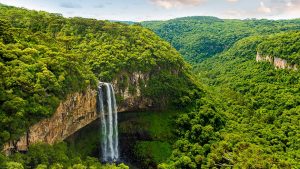
The Amazon rainforest has been fascinating to me since reading Journey to the River Sea by Eva Ibbotson, which takes place in Amazonia. Since then, I have thought of the Amazon as being an abundant, lush, beautiful, and massive rainforest. While it still is all these things, unfortunately, my idea of it turned out to be not as accurate as I hoped. As issues like deforestation and climate change have become more and more prevalent in recent years, the Amazon has fallen victim. Although I was aware of this, I did not realize how big the problem was until I visited the Amazonia exhibit at the Museum of Anthropology. I also did not know about the other problematic truths about the Amazon, including things happening to Indigenous people in Brazil.
At the Amazonia exhibit, I learned that 45% of the Amazon is protected natural areas and Indigenous territories. This kind of disturbed me, as that is less than half. Even worse, 84% of the Peruvian surface area of the Amazon is dedicated to oil production. The Amazon rainforest is one of the most bountiful areas in the world. It provides the Earth with 20% of its oxygen, over half of the 10 million species of plants, animals, and insects, and 1/5 of the world’s fresh water. For an area that provides so much for us, at the very least, much more than half should be protected. Then, we have the majority of the Peruvian Amazon being devoted to producing oil, a non-renewable, non-sustainable, and polluting resource. We are consciously wrecking an extremely plentiful bank of resources that our planet needs.
One of the main causes of deforestation in the Amazon is cattle ranching. This was interesting to me because I have heard vegan activists explaining that eating meat is harmful to the environment, but I never took it upon myself to actually find out why. But, if cattle ranching is responsible for 65-70% of deforestation in the Amazon, it is quite clear how the production of meat for consumption is destructive. This has inspired me to not only discover more about cattle ranching practices in Amazonia and around the world but to lower my own animal product consumption.
I was shocked to learn that it is not only the flora and fauna of Amazonia that is being destroyed – but the Indigenous people, too. From 2003 to 2015, there were 891 targeted assassinations of Indigenous people in Brazil. This reminds me of the Canadian national crisis of the missing and murdered Indigenous women in Canada. This is a huge problem in Canada, so it is heartbreaking to know that Indigenous people are being targeted around the world, not just in Canada. In addition, Amazonia is an extremely complex environment, that probably nobody understands as well as the Indigenous people of the area. They may be crucial to the sustainability of Amazonia, but they are also people themselves – they do not deserve to be targeted or removed from land they own.
The Amazonia exhibit really opened my eyes. I got to see some of the species of beautifully coloured birds and learn about the ways of life of people who live in the Amazon. But, I was also exposed to facts that show how a place that I have always glorified has some dark sides, too.
Sources